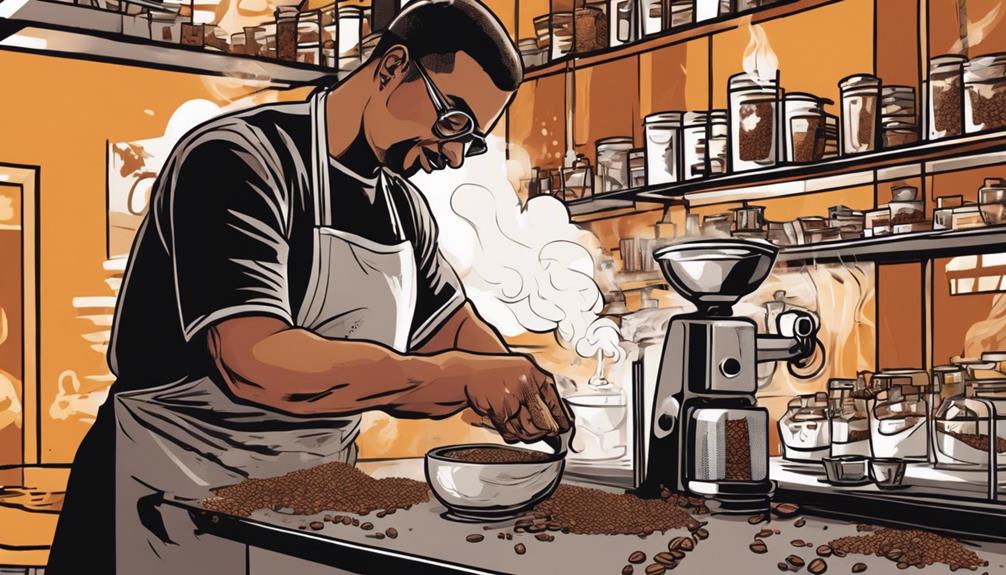Mix your coffee using beans from different sources, roasts, and types. Achieve balance in your blend by experimenting with proportions and cupping methods. Take into account acidity, sweetness, and bitterness to craft a well-rounded cup. Explore regional flavors for unique profiles. Create unforgettable sensory experiences by mastering blending techniques and roast levels. Connect with coffee blending communities for advice and networking. Try out different beans, proportions, and flavors to develop your own special blend. Unleash your creativity to discover a world of unmatched coffee flavors that await you.
Key Takeaways
- Experiment with various beans, origins, and roast levels for complexity.
- Balance acidity, sweetness, and bitterness for a harmonious cup.
- Utilize different blending techniques like layering and accenting.
- Consider chemical compounds and sensory experiences for unique flavors.
- Craft a signature blend by adjusting ratios and flavor profiles.
Coffee Blending Essentials
To craft outstanding coffee blends, you must understand the key elements of coffee blending. Coffee blending involves combining beans from different origins, roast levels, and varietals to create a unique flavor profile.
By blending beans with various tasting notes, roasters can achieve a balanced and intricate blend that enhances the overall flavor experience.
When creating a blend, it's pivotal to roast each component separately to the ideal level before combining them. This process allows for best flavor development and guarantees that each bean contributes its distinct characteristics to the final blend.
Experimenting with different ratios and blending methods such as classic, accent, layered, or single-origin blends can help roasters find the perfect balance and create a harmonious flavor fusion.
Using cupping techniques to evaluate flavor profiles is crucial in refining your skills in coffee blending. Through careful analysis and adjustment of blends, you can hone your palate and develop a deeper understanding of how different beans interact to create a truly exceptional cup of coffee.
The Science of Flavor Fusion
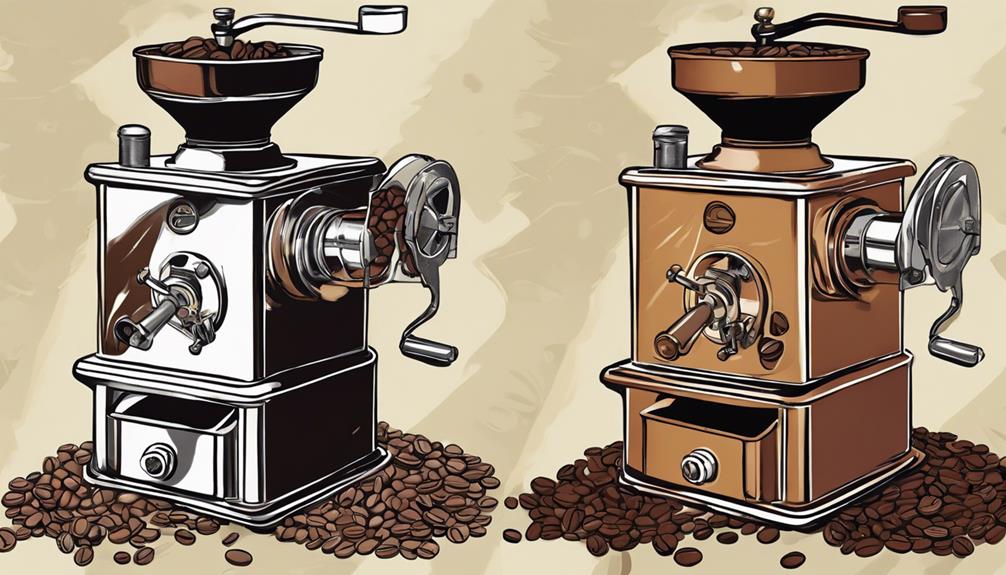
Understanding the chemistry behind flavor fusion is vital for creating exceptional coffee blends that tantalize the taste buds. When blending coffee for unique tastes, the goal is to achieve a harmonious flavor experience by combining beans with different taste profiles. Achieving optimal coffee bean blending involves understanding the chemical compounds in each type of bean and how they interact to create specific flavors. It’s important to consider factors such as the roast level, origin, and processing method of the beans when creating a blend. By experimenting with different combinations and ratios, coffee roasters can ultimately discover the perfect balance for a truly exceptional flavor fusion.
This process involves balancing acidity, sweetness, bitterness, and other flavor components to create a well-rounded cup of coffee. To craft signature blends that stand out, it's essential to ponder the various chemical compounds that contribute to flavor perception in the final brew.
Experimenting with different ratios of beans, roast levels, and origins is key to mastering the art of flavor fusion. By delving into the intricacies of taste complexities, you can create blends that offer a truly unforgettable sensory experience.
Whether you're aiming for a bold and robust flavor or a delicate and nuanced profile, understanding the science behind flavor fusion will help you craft coffees that leave a lasting impression on discerning palates.
Bean Selection Tips
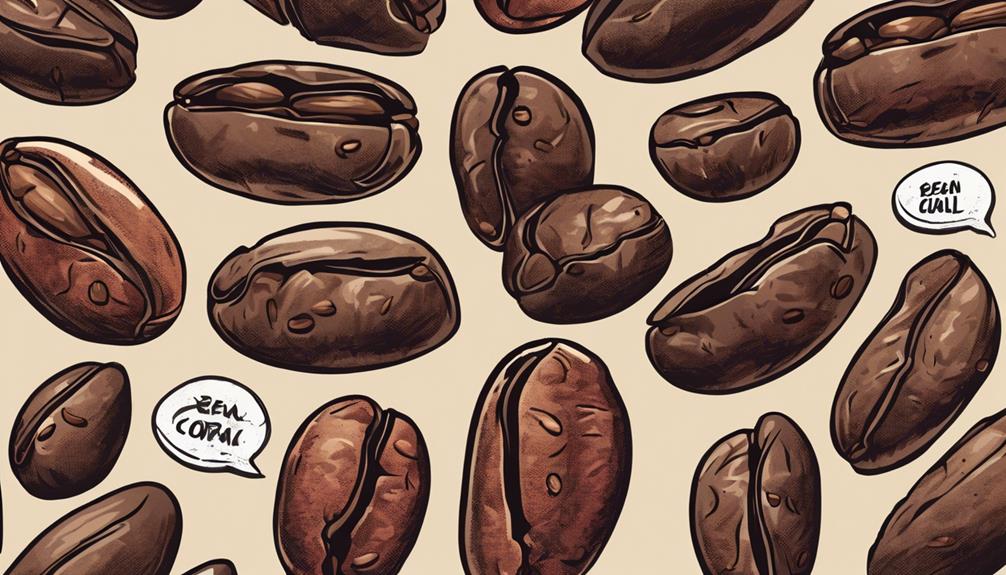
When selecting beans for your coffee blend, consider the variety, origin, and roast level to craft a unique flavor profile.
Experiment with beans from different regions like Africa, Latin America, and Asia to discover distinct tasting notes.
Mixing various roast levels can add complexity and depth to your final blend.
Bean Variety Considerations
Take into account various factors such as the origin, roast level, varietals, and quality of beans when selecting components for your coffee blend. Arabica and Robusta are common bean varieties to contemplate; Arabica is renowned for its nuanced flavors, while Robusta provides a strong, bold taste.
Experiment with beans from different regions like Central American, African, and Asian countries to introduce diverse flavor notes into your blend. When blending, play around with different ratios of beans to achieve the perfect balance of flavors and aromas.
Moreover, mixing beans with varying roast levels can add depth and complexity to your coffee blend, creating a more dynamic taste profile. Various varietals within the Arabica family, such as Bourbon or Typica, offer specific flavor profiles that can be customized to your preferences.
Always prioritize using high-quality, freshly roasted beans as the foundation for your blend to guarantee a superior final product.
Origin Influence on Taste
To enhance the flavor complexity of your coffee blend, focus on the origin of the beans you select, as it greatly influences the taste profile you aim to achieve. Different regions offer unique characteristics that can contribute to a harmonious blend. Consider beans from Africa for fruity and floral notes, Latin America for chocolate and nutty flavors, and Asia for earthy and spicy tones. Experimenting with single-origin beans allows you to understand their unique qualities before combining them to create a complex flavor profile. Combining beans from various origins can lead to exciting and diverse flavor combinations in your coffee blend. Select beans based on the desired flavor notes you wish to highlight, and be open to exploring the terroir influences from different coffee-growing regions. This thoughtful selection process will result in a truly distinctive and flavorful coffee blend.
| Origin | Flavor Profiles | Unique Characteristics |
|---|---|---|
| Africa | Fruity and Floral | Bright acidity |
| Latin America | Chocolate and Nutty | Balanced body |
| Asia | Earthy and Spicy | Bold flavors |
Roast Level Impacts
Choosing the right roast level for your coffee beans is vital as it greatly impacts the flavor, aroma, and body of your final blend. Different roast levels, such as light roasts and dark roasts, offer distinct characteristics to your coffee. Light roasts bring out mellow and subtle flavors, while dark roasts provide bold and intense notes.
To secure flavor consistency in your blend, match the roast levels across all components carefully.
Experimenting with various roast levels can add depth and complexity to your coffee blend. By selecting specific roast levels, you can highlight particular tasting notes, enhancing the overall flavor profile. Whether you prefer a brighter and acidic taste or a richer and smokier flavor, the roast level plays an essential role in achieving your desired blend.
Mastering Blending Techniques

To become skilled at mastering blending techniques, it's vital to understand how different beans interact to achieve a desired taste balance. Blending involves combining beans from various origins, roast levels, and varietals to create unique flavor profiles.
By experimenting with blending ratios, roast levels, and bean combinations, you can craft innovative and delicious coffee blends. Precision in measuring and roasting each component separately is essential for successful blending.
Exploring different blending methods such as classic, accent, layered, and single-origin blends opens up a world of flavor possibilities. Each method offers a distinct approach to creating harmonious taste experiences.
Whether you prefer a bold and complex blend or a subtle and nuanced one, mastering blending techniques allows you to tailor your coffee to suit your unique preferences. Embrace the art of blending to reveal the full potential of your coffee beans and enhance your coffee brewing experience.
Roasting for Flavor Development
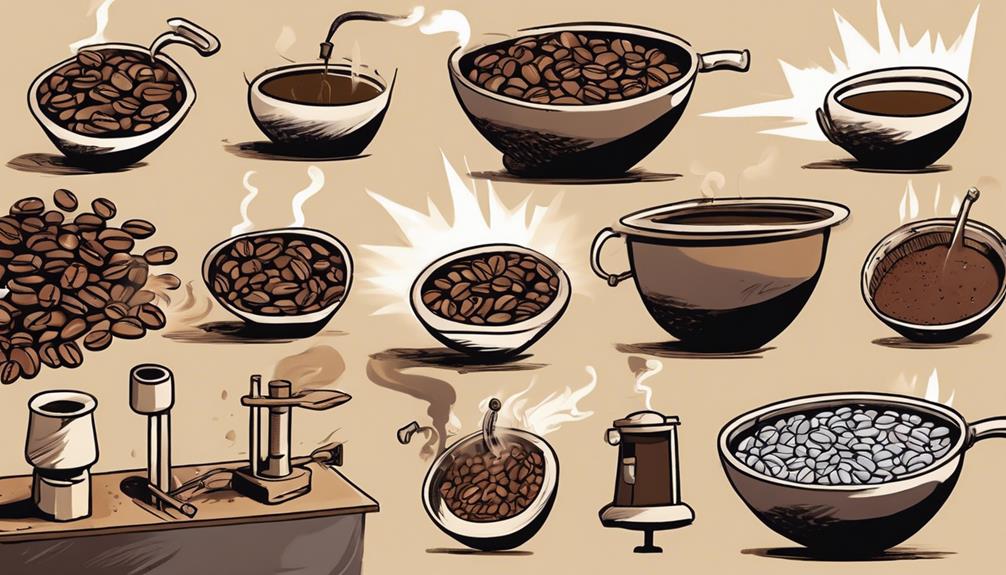
When roasting coffee beans for flavor development, consider how different roast levels impact the taste profile of your blend. Each roast profile – light, medium, and dark – plays an essential role in shaping the flavors and aromas of your final cup.
Here are some key points to keep in mind:
- Light roast: Preserves the unique characteristics of the beans, offering higher acidity and milder flavors.
- Medium roast: Strikes a balance between acidity and body, creating a well-rounded taste experience.
- Dark roast: Brings out oils in the beans for bold, smoky flavors with reduced acidity.
Roasting for flavor development influences the sugars, acids, and oils in the beans, ultimately defining the taste of your blend.
Roast profiles matter. Choosing the right roast level is critical for achieving the desired flavor complexity in your coffee blend.
Understanding how roasting impacts flavor development will help you craft a unique and enjoyable coffee blend tailored to your preferences.
Fine-Tuning Your Blend
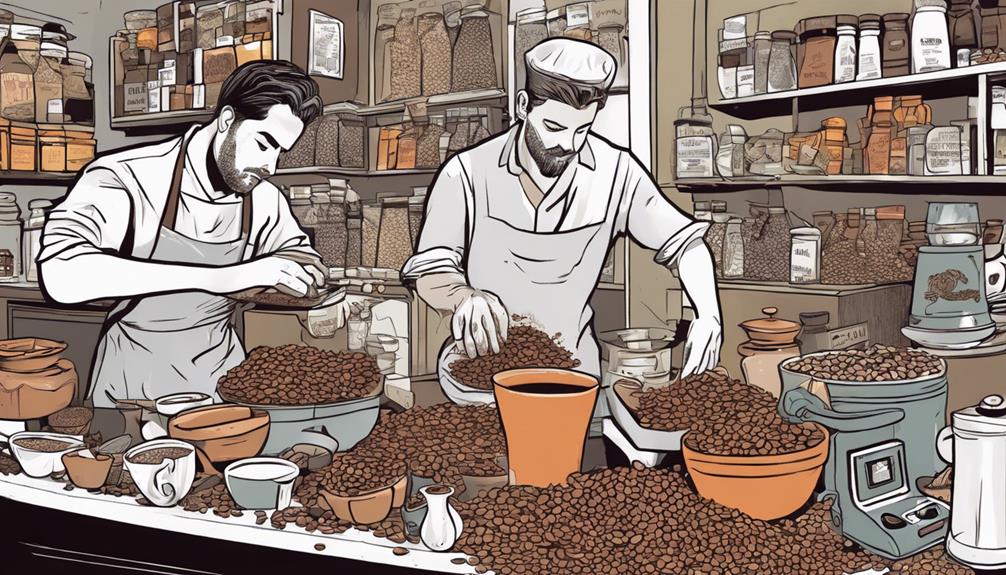
Experiment with different blending ratios and roast levels to achieve the perfect balance of flavors in your coffee blend.
Use cupping techniques to evaluate and refine the nuances, and consider adding beans with specific flavor notes for complexity.
Keeping detailed records will help track changes and improvements in your blend.
Blend Complexity Techniques
Fine-tune your coffee blend by exploring various techniques to enhance complexity and depth in its flavor profile.
To craft a unique blend that captivates your taste buds, consider the following:
- Experiment with classic, accent, layered, and single-origin blend techniques: Mix and match different types of beans to create a blend that's both familiar and intriguing.
- Create a balanced blend: Make sure that each bean in your blend contributes equally to achieve a harmonious flavor profile.
- Utilize accent blends: Add specific accent beans to highlight desired flavor notes and introduce layers of complexity.
- Layer different roast levels: Build depth and complexity by incorporating beans roasted to varying levels in your blend.
- Explore single-origin blends: Showcase the unique terroir and flavors of a single region to create a blend that offers a more nuanced taste experience.
Flavor Balance Strategies
How can you achieve the finest flavor balance in your coffee blend through strategic adjustments? Achieving the perfect balance of flavors in your blend involves experimenting with different beans, roast levels, and origins. By adjusting the ratios of beans with various tasting notes, you can create a harmonious flavor profile that balances acidity, body, sweetness, and bitterness. To fine-tune your blend, consider conducting cupping sessions to evaluate the taste and make precise adjustments for optimal flavor balance. Understanding how different beans interact is key to creating a well-rounded and satisfying taste experience.
| Flavor Balance Strategies | Tips to Achieve Finest Flavor Balance |
|---|---|
| Experiment with different | Try various beans, roast levels, and origins to find the perfect blend tastes. |
| Adjusting ratios | Fine-tune your blend by adjusting the ratios of beans with different tasting notes. |
| Create harmonious flavor profile | Balance acidity, body, sweetness, and bitterness to achieve a harmonious flavor profile in your blend. |
Tasting and Adjusting

To evaluate the flavor notes and make necessary adjustments in your coffee blend, utilize the cupping technique and take detailed notes on taste, aroma, and overall impression. Tasting and adjusting are vital steps in the coffee blending process to create a unique and delicious blend.
Here are some key points to keep in mind:
- Tasting: Engage your senses fully to identify the different flavor notes present in the blend.
- Adjusting: Be ready to tweak blend ratios or roast levels to enhance or balance specific flavors.
- Flavor Notes: Pay close attention to the individual flavors that stand out in the blend.
- Blend Ratios: Experiment with different proportions of each coffee variety to achieve the desired taste.
- Desired Flavor Profile: Bear in mind the specific flavor profile you aim to achieve with your blend.
Community Insights and Connections

Engage actively with coffee blending communities to gain valuable insights and connections with fellow enthusiasts. Join platforms like Home-Barista and CoffeeGeek to tap into a wealth of community insights. These connections can provide you with valuable feedback and expose you to different approaches to coffee blending for unique tastes.
If you're looking to enhance your skills further, consider enrolling in courses offered by places like Boot Coffee Campus. These courses focus on advanced roasting techniques, helping you deepen your understanding of coffee blending.
Additionally, seek advice from experienced roasters on platforms like Perfect Daily Grind to refine your coffee blending techniques. By actively participating in these communities, you'll have the opportunity to explore new blends and techniques, enriching your coffee blending journey.
Crafting Your Signature Blend

When crafting your signature blend, you can experiment with a variety of beans to achieve a unique flavor profile.
Try different blending ratios to balance flavors and create a harmonious taste that suits your preferences.
Consider the origins, roast levels, and varietals of the beans to craft a blend that highlights the flavors you enjoy most.
Blend Development Process
Crafting your signature blend involves a meticulous process of selecting beans with distinct flavor profiles. To create a truly unique and balanced blend, follow these steps:
- Selecting Beans: Choose high-quality beans with diverse flavor profiles to bring complexity to your blend.
- Experiment with Different Ratios: Try various combinations of beans in different proportions to discover the ideal balance of flavors.
- Roast Each Component Separately: Enhance the individual characteristics of each bean by roasting them separately before blending.
- Flavor Melding: Allow the blended beans to rest after mixing to let the flavors harmonize and develop depth.
- Keep Detailed Notes: Document each step of the blend development process to track your progress and make adjustments for future batches.
Flavor Profile Exploration
Examine the flavor profiles of different coffee beans to create your signature blend with unique tastes. Investigate a variety of coffee beans from different regions to reveal distinct notes and characteristics.
By combining beans with varying acidity levels, body textures, aromas, and finishes, you can create a harmonious flavor profile that delights your taste buds. Think of blending coffee beans as conducting a symphony of flavors, where each bean plays an essential role in the final composition of your brew.
The process of flavor profile exploration allows you to personalize your coffee experience and develop a blend that's truly one-of-a-kind. Experimenting with different combinations will help you discover new and exciting taste sensations, elevating your coffee-drinking journey to a whole new level.
Embrace the art of combining coffee beans to uncover a world of possibilities and savor the rich complexities that arise from your unique blend.
Exploring Regional Flavors

Explore the world of coffee by investigating the varied flavors that each region has to offer. When it comes to crafting unique coffee blends, exploring regional flavors can provide a delightful journey for your taste buds.
By blending beans from regions such as Central and South America, you can immerse yourself in the specialty coffee scene and uncover a world of diverse aromas and tastes.
Regional blends showcase the diverse flavors of specific coffee-growing areas. Combining beans from regions like Central America or Africa highlights unique terroir characteristics.
Blending beans from regions such as Guatemala, Honduras, or Costa Rica offers a taste of vibrant coffee cultures. Regional blends allow for experiencing the distinct flavors and profiles of various coffee-growing regions.
Each regional blend brings a unique taste experience that reflects the coffee-growing diversity of the area.
Frequently Asked Questions
How Do You Make Special Blend Coffee?
To make special blend coffee, you carefully mix beans from various origins and roast levels. Select unique beans with specific flavor profiles. Blend with precision in ratios and roast levels. Experiment with combinations for a distinct taste.
How to Infuse Coffee With Flavors?
To infuse coffee with flavors, start by adding spices, syrups, extracts, or oils. Experiment with vanilla, caramel, hazelnut, cinnamon, or coconut. Blend in chocolate, fruits, herbs, or citrus zest for unique tastes. Customize your coffee experience!
How Do You Blend Coffee Flavors?
To blend coffee flavors, start by selecting beans with diverse profiles. Experiment with ratios to craft a balanced cup. Roast components separately for distinct tastes. The art of blending demands precision and creativity. To achieve a harmonious blend, consider the body, acidity, and aroma of each bean. Take note of the brewing method and adjust the blend accordingly. To understand how to blend coffee effectively, it’s important to taste and analyze each component to identify their unique qualities. Experimenting with different combinations and techniques is key to mastering the art of blending coffee.
How to Make Different Flavours of Coffee?
To make different flavors of coffee, experiment with spices like cinnamon, nutmeg, or cardamom. Infuse extracts such as vanilla, almond, or hazelnut. Try syrups like caramel, mocha, or peppermint. Mix in alternative milks for a creamy texture.
Conclusion
Now that you've mastered the art of blending coffee, the possibilities are endless. With the right techniques and a little creativity, you can create a signature blend that's uniquely yours.
Whether you prefer a bold and rich flavor or a light and fruity taste, experimenting with different beans and roasting methods will help you find the perfect fusion of flavors.
So grab your coffee grinder and start blending – your taste buds will thank you!
